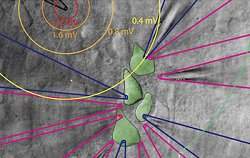| A aglicona lomaiviticina só era produzida até agora em quantidades mínimas por uma bactéria marinha rara. |
Aglicona lomaiviticina
Uma equipe de cientistas da Universidade de Yale, nos Estados Unidos, sintetizou pela primeira vez um composto químico chamado aglicona lomaiviticina.
Químicos em todo o mundo têm estado interessados nas propriedades anticancerígenas da lomaiviticina desde sua descoberta em 2001.
Mas, até agora, eles não haviam conseguido obter quantidades significativas do composto, que é produzido por uma bactéria marinha rara (Micromonospora), que não pode ser facilmente persuadida a produzir a molécula em grandes quantidades.
Na última década, vários grupos ao redor do mundo têm tentado substituir a bactéria, sintetizando o composto natural em laboratório, mas sem sucesso.
Células-tronco do câncer
Tendo conseguido fazer isto agora, os cientistas acreditam poder caminhar rapidamente rumo ao desenvolvimento de uma nova classe de fármacos para alvejar e destruir as progenitoras, as chamadas células-tronco do câncer.
"Cerca de três quartos dos agentes anticancerígenos são derivados de produtos naturais, de modo que houve muito trabalho nesta área," conta Seth Herzon, que coordenou a pesquisa. "Mas este composto é estruturalmente muito diferente dos outros produtos naturais, o que tornou extremamente difícil sintetizá-lo em laboratório."
Além da aglicona lomaiviticina, a equipe de Herzon criou também moléculas similares menores, que se provaram extremamente eficazes na destruição das células-tronco do câncer de ovário.
Câncer de ovário
Os cientistas estão particularmente entusiasmados com a possibilidade da aglicona lomaiviticina destruir as células-tronco do câncer de ovário porque a doença é notoriamente resistente ao taxol e à carboplatina, duas das drogas mais usadas na quimioterapia da doença.
"O câncer de ovário tem uma alta taxa de recorrência, e depois de usar a quimioterapia para combater o tumor pela primeira vez, você fica com as células tumorais resistentes que tendem a voltar," explica Gil Mor, outro membro da equipe.
"Se você puder matar as células-tronco antes que elas tenham a chance de formar um tumor, a paciente terá uma chance muito maior de sobrevivência - e não há, por enquanto, muitas terapias potenciais para alvejar as células-tronco do câncer," comenta.
Testes em animais
Para sintetizar a molécula tão valiosa, os cientistas usaram uma técnica de 11 etapas, o que é considerado por eles como uma solução bastante simples, ainda que um dos passos tenha consumido um ano inteiro de pesquisas.
"Um monte de sangue, suor e lágrimas foram derramados para formar essa ligação," dramatiza Herzon. "Depois disso, o resto do processo foi relativamente fácil."
Agora, a equipe pretende analisar os compostos para entender melhor como ele interage com as células-tronco em nível molecular.
Os cientistas esperam começar a testar os compostos em animais em breve.




